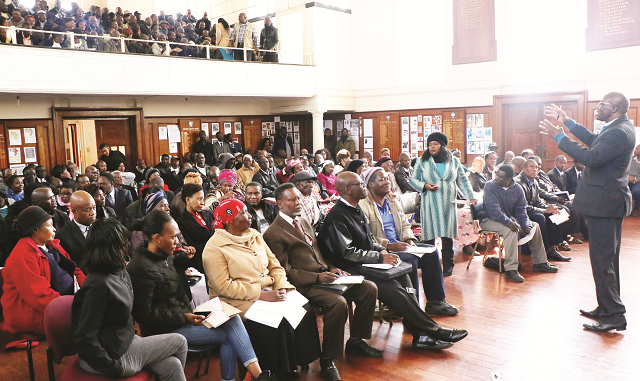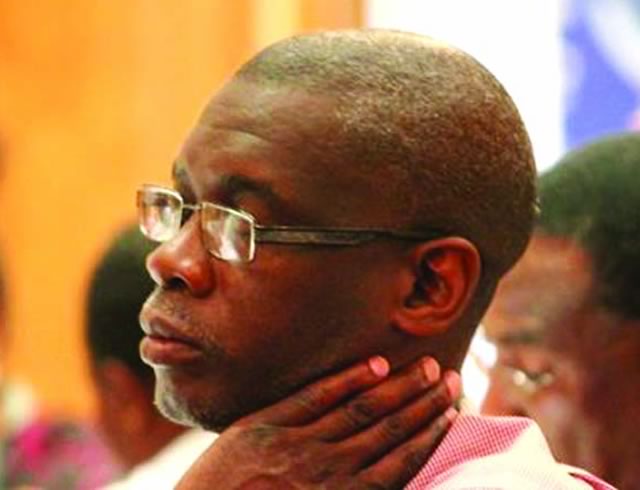Chamisa’s much ado about Zec, ballot paper


Provincial Elections Officer for Bulawayo Mr Innocent Ncube addresses political parties’ aspiring candidates during a stakeholders engagement meeting in Bulawayo in this file photo
Vusi Nyamazana, Correspondent
Voters enter the voting booth already having their candidate of choice, and the candidate’s photo and the party emblem are easily identifiable and easily draw the voter to a particular party and candidate. Is there any evidence to support their argument that voting behaviour is influenced by the position of the candidate’s name on the ballot paper?
Change is in the air for this election — in more ways than one. Voters in Zimbabwe will be presented with a new format ballot paper on July 30, 2018. They will not see the usual ballot paper, where presidential candidates are listed one below the other in single column.
The MDC Alliance has jumped all over Zec criticising it on almost everything. They have a case of foot-in-mouth disease — the moment they open their mouth about Zec, wrong things without substantial purpose fly out.
This time around they have cynically and disingenuously criticised the ballot paper design as they wanted a portrait ballot which supposedly gave their candidate advantage of being on top. The biggest threat to election integrity is an opposition party with nefarious intent.
I am concerned, however, that much of the opinion they have given is simply that and very little evidence has been provided to support the contentions that the two-column ballot with President Mnangagwa positioned on the top right amounts to unfair and partisan ballot placement.
Voters enter the voting booth already having their candidate of choice, and the candidate’s photo and the party emblem are easily identifiable and easily draw the voter to a particular party and candidate. Is there any evidence to support their argument that voting behaviour is influenced by the position of the candidate’s name on the ballot paper? To what extent is the “two-wing” layout a problem?
Will the design pose any confusion at voting stage or cause any difficulties at the stage of counting?
The design of the ballot paper meets normative and legal expectations because it enables the voter to indicate their chosen candidate or party at an election. The design makes it easy for the voter to:
a) understand what the ballot paper is, for;
b) find their chosen candidate or party;
c) mark their choice in such a way that their vote is valid, and reflects their intention. The US 2000 Palm Beach presidential election ballot paper failed to meet most of the above criteria. The butterfly ballot paper caused genuine controversy.
The ballot paper designed by Theresa Lepore had names down both sides, with the punch holes in the centre. Court cases lodged against this ballot claimed the design led to thousands of people mistakenly voting for the Reform Party candidate Pat Buchanan when they meant to vote for Democrat Al Gore.
Mr Gore’s name was the second on the left of the ballot paper, but voters had to punch the third hole to vote for him. If I compare this with Zec’s ballot paper I only conclude that the furore raised by MDC Alliance is nothing more than a ruse to discredit Zec and its commissioners.
In designing the ballot, Zec considered several criteria for appropriateness of design — voter understanding, easiness of voting, voting integrity, cost and compatibility with election legislation. It is common many times the criteria chosen as important will contradict each other — and Zec had to prioritise the criteria against a context of an unprecedented 23 Presidential candidates. The electoral regulations do not specifically regulate whether the ballot has to be portrait or landscape, leaving Zec to use its discretion in the face of space constraints. The law specifically requires that names appear on the ballot paper in the order dictated by the alphabetical listing of candidates surnames, which Zec has fulfilled.
The size or format of a ballot paper is, of course, dependent on the number of candidates standing. Zec changed the layout to run from left to right so as to accommodate the long list of 23 Presidential candidates. The long portrait format would have led to confusion among some voters, and the font size will not have been large enough for those with sight impairment to understand the ballot paper more readily.
We need to recognise that the implications of the new format need to be considered not only from the point of view of including more candidates, but also from the point of view of the logistics of the printing process. Printing presses come in pre-specified sizes (A3, A2, A1 etc) and therefore the size of paper determines how it can be printed. The long portrait ballot paper could have added difficulties for Zec in sourcing a supplier able to meet the paper size and appropriate printing press. The long format ballot paper could have necessitated acquisition of new printers by Fidelity Printers and or even a change to printers outside Zimbabwe.
We should also be aware that any increase in the size of ballot papers can have an impact on the suitability of current voting booths, and there can be difficulties in voters using the currently available booths when very long ballot papers are presented to them.
In view of the practical considerations and concerns noted above, I argue that the “two-wing” ballot should cease to be a hotly contested issue, and that candidates should focus on campaigning in these few days left. Zec should continue focused on delivering a credible election, and is justified in its design of the ballot paper since it meets the following normative and legal requirements:
1. Ballot design suits the exceptional circumstances of a long list of Presidential contenders.
2. It meets the legal requirement of alphabetical listing of candidates surnames.
3. The design does not confer any a priori advantage to one candidate over another.
4. Ballot format does not determine or condition an election outcome.
5. There is no evidence of bias towards those positioned higher up the ballot paper.
6. There is no evidence to support the argument that voting behaviour is influenced by the position of the candidate’s name on the ballot paper.
7. The design of the ballot paper does not contravene the normative assumption of electoral neutrality.
8. The law does not impose a standard style for all ballot papers, and Zec has discretion to change the Presidential ballots required this change.
Vusi Nyamazana is political analyst and Team Leader at Mnangagwameter (http://mnangagwameter.polimeter.org), a think-tank that focuses on tracking the progress made by the administration of President Emmerson Mnangagwa.











Comments